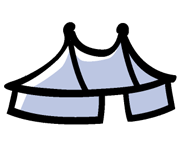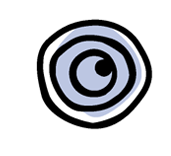Tribune de Lyon8 November 2010
NEW CIRCUS
Cirque Plume on canvas
Taking the title of its new show from a painting by its compatriot from Besancon, Gustave Courber, the troop led by Bernard Kudlak has entered the world of the history of art, as well as entertaining us at the museum.
In one scene, Venus as painted by Velasquez takes shape and comes to life. In another, shimmering fabrics from canvasses by Klimt are draped over flesh and blood models. Elsewhere, two mischievous clowns take the stage, Pedro and Oui-Oui, messing about with a giant stamp covered in blue ink in the manner of Yves Klein. There is a succession of tableaux - in the proper sense, in addition to the other meaning of the ’paintings’ that Cirque Plume invites us to admire in its production of ’l’Atelier du peintre’ (the artist’s workshop). Two "oldies", Robert and Pierre, act as guides and court jesters. When they aren’t posing nude as Gabrielle d’Estrées and the Duchess de Villars in the bath, our compères are making their own witty remarks ("I think Rembrandt had a very dark side. - That’s clear!") or they are splashing paint about enthusiastically, jousting in an explosion of colour. These little burlesque comedy acts that trigger laughter from the young audience - almost as much as when poor Padpo is stripped completely naked by the naughty Pedro and Oui-Oui, come between acrobatic numbers that have the clockwork precision for which the Doubs area has earned its reputation.
JOINT EFFORT
A show from Cirque Plume is always a marvel, a collective celebration where each one of the fourteen members of the troop is given his own solo and is able to express himself in his own way, whether it’s a virtuoso juggling display using shadow play, making music from a block of expanded polystyrene, bouncing on a trampoline in a short skirt or performing acrobatic feats in a dustbin. In spite of its similarity to the senseless chaos of a Prévert inventory poem, ’l’Atelier du peintre’ does in fact its own rigid structure, and the lyrical fantasy that runs through each of the ’tableaux’ echoes that which pervades the spirit of an artist. Expressive, open to every experience, it can be expressed in a musical composition, a painting, acrobatics, choreography or a piece of theatre, combining more than one discipline to provide the audience with a feast for the senses. It is a multi-media work that is performed live each time, an old master canvas painted by twenty eight hands that has the additional advantage of being able to spring out of its frame.
Vincent Raymond










